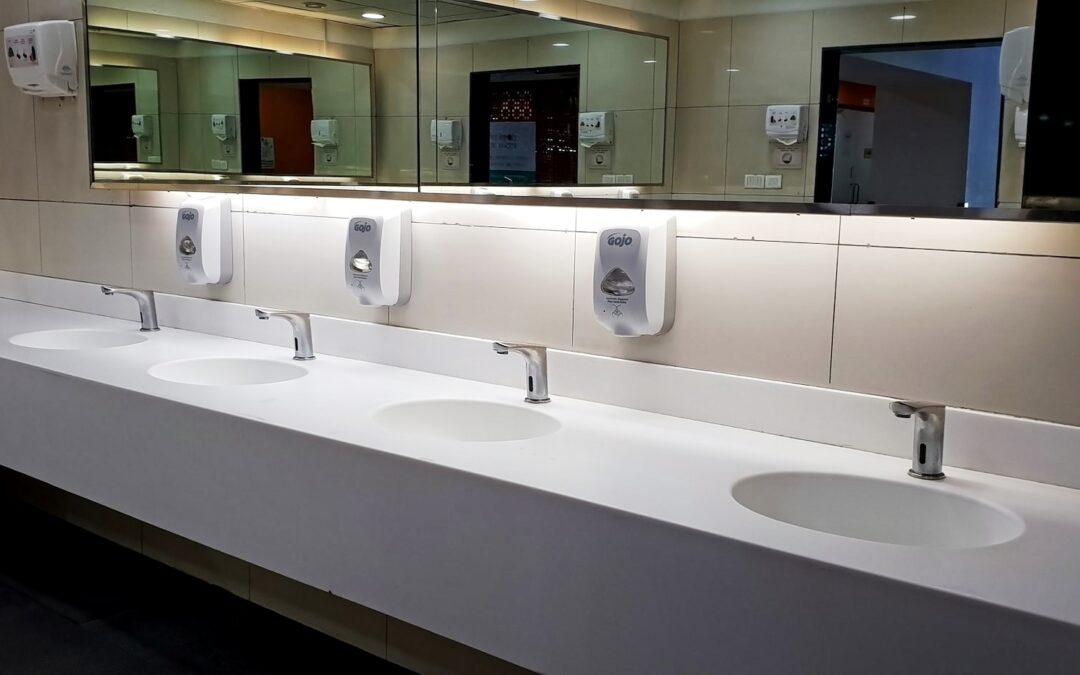In the wake of the post-pandemic era, commercial restroom design is undergoing a significant transformation. As people return to work and public spaces, there’s an escalating demand for touch-free, sensor-operated amenities like faucets, soap dispensers, hand dryers, and flushometers. This surge in demand is anticipated to persist, prompting an exploration of novel design paradigms that ensure both functionality and aesthetics. In this article, we delve into the latest trends reshaping commercial restroom design.
Touch-Free Revolution and Traffic Flow Management
The aftermath of the pandemic has amplified the preference for touch-free restroom elements. Sensor-operated faucets, soap dispensers, hand dryers, and flushometers are becoming the norm, catering to heightened hygiene expectations. Concurrently, the layout of public lavatories is adapting to the need for social distancing and improved traffic flow. Partitions between urinals and sinks, coupled with distinct entrances and exits, are orchestrating a seamless movement while averting crowding.
Integration of Natural Elements and Outdoor Aesthetics
Incorporating the essence of the great outdoors into restroom design is gaining momentum. Commercial restrooms are embracing shapes, colors, and textures reminiscent of nature.
Moreover, the inclusion of live plants within the design introduces a touch of nature’s tranquility indoors. This infusion of natural elements not only adds warmth to the space but also contributes to reducing tension and promoting well-being as employees return to the workplace.
Redefined Sink Configurations and Layouts
Conventional norms are being redefined, particularly regarding sink placements. Floating sinks and vanities are emerging as a popular choice in contemporary offices and even restaurants. The innovation extends to arranging a series of sinks within the central area of the restroom, offering occupants a refreshing and novel experience. Such creative configurations amplify both functionality and aesthetics.
Navigating ADA Requirements with Finesse
Adhering to the Americans with Disabilities Act (ADA) guidelines remains pivotal. Commercial restrooms must align with ADA stipulations to ensure inclusivity and accessibility. These regulations encompass various aspects such as dimensions of handicap stalls, door sizes, grab bar placements, and dispenser heights. By meticulously adhering to these standards, establishments are fostering an environment of equal opportunity and comfort for all patrons.
California’s Unique Regulations
The state of California boasts distinctive regulations governing commercial restroom provisions. Ensuring access to adequate restrooms during peak hours in public spaces is paramount. This mandate extends to various establishments, including sports arenas, amusement parks, community halls, and event centers. Notably, California mandates that retail businesses must open employee-only restrooms to the public for individuals with specific medical conditions.
Promoting Gender-Neutral Spaces
California is at the forefront of promoting gender-neutral restrooms. The Equal Restroom Access Act mandates single-occupancy restrooms to be designated as gender-neutral. This inclusivity-driven approach fosters a sense of acceptance and comfort among diverse groups.
Innovative CA Restroom Examples
California sets an example with innovative restroom designs. Los Angeles International Airport (LAX) introduced a gender-neutral restroom featuring an adult changing table, catering to travelers with special needs. In Hermosa Beach’s Clark Field, restrooms designed for the public are a testament to inclusive design principles. The upcoming 2200-square-foot public restroom in LA’s parking structure on Vine Street speaks of a commitment to convenience and accessibility.
For more insights into LA Creed’s impactful role in commercial construction financing, visit https://creedla.com.

